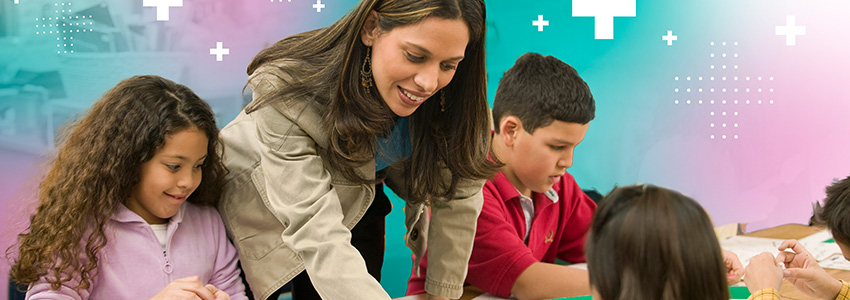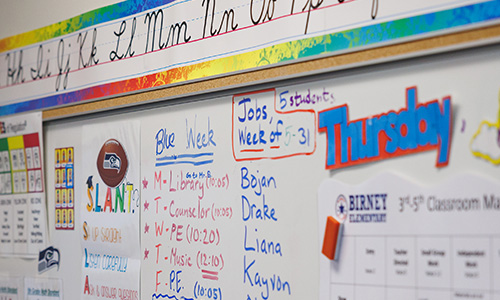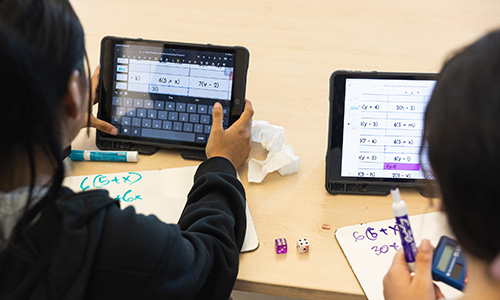
Back when we were in schools every day, we were constantly on the lookout for resources to support rich, rigorous, mathematical learning. Although many of the teachers we worked to support liked the concrete-representational-abstract framework of their math curriculum, we frequently heard them express frustration over the rote practice problems provided in most of their resources. Teachers were spending a lot of time looking for content that went beyond a standard worksheet. They were telling us they wanted activities that would spark student excitement and encourage deeper thinking, like Open Middle math problems.
When paired with number talks, Open Middle problems can help teachers embed rich conversation throughout math class.
Defining the problem
So, what exactly are Open Middle math problems? In an Open Middle problem, students are given starting information and either an answer or a definition of the answer. By “definition of the answer,” we mean that students are given a description of the type of answer toward which they are driving. For example, many Open Middle math problems ask students to find the least or greatest solution or a number that is closest to a given number. How they get from start to end is up to them. Rather than following a solution path that was stepped out for them by the teacher, the path is completely under their control.
The best way to understand an Open Middle math problem may be to compare one to a typical textbook problem for the same topic. For a lesson on three-digit subtraction, a standard textbook might ask students to find 539 – 286 either as a straight computation item or embedded within a word problem. By contrast, an Open Middle math problem for the same topic asks students to use the digits 1–9, at most one time each, to make two three-digit numbers with a difference as close to 329 as possible.
Although understanding of place value, regrouping, the relative magnitude of numbers, and the relationship between addition and subtraction underlie both types of problems, with the more traditional problem, a student can answer correctly by following a set of learned steps without truly understanding the conceptual underpinnings. However, students must actively engage with these concepts to solve the Open Middle math problem. The open structure forces students to consider these concepts and constantly make decisions and adjust their solution path. Here are some of the questions students might consider when solving the Open Middle math problem:
- What strategies can be applied to solve? Should I subtract? Should I add up? Can estimation help?
- Should I focus on a certain place value for each number first, or should I create one number completely?
- Is it possible to make two numbers where regrouping will not be required?
- Is it possible to get exactly 329?
Open Middle problems can also be word problems. While some Open Middle math problems are structured this way, others can easily be turned into word problems. For example, the three-digit subtraction problem above can be rewritten as a word problem such as this: Jared and Suni are playing a video game. Each of their scores were three-digit numbers. Jared’s score was 329 less than Suni’s. Use the digits 1–9, at most one time each, to make two three-digit numbers that could be Jared and Suni’s scores.
It’s the journey, not the destination
Because of the way they are designed, Open Middle math problems emphasize process over product. While students are still expected to arrive at a defensible answer, Open Middle problems push students to utilize a variety of mathematical skills and understandings to wrestle with the problem. The goal is not to be the quickest to follow a predetermined solution path but, rather, to allow for a more iterative approach where students continually test and revise strategies. Dan Meyer terms this “patient problem solving,” where students bring all their mathematical knowledge and intuition to bear on solving non-routine problems. The active engagement that this engenders supports rich mathematical thinking and discussion amongst students.
One of the co-developers of Open Middle problems, Nanette Johnson, describes their value this way: “This structure requires students to prove to themselves and others that they have truly found the best possible answer. Rather than putting down their pencils and saying, ‘I’m done,’ students continue to think, argue, and work. They develop the habit of making multiple attempts to solve the problem, each time wondering if they can come up with an even better solution than their last.”
The fact that students can arrive at different answers naturally prompts discussion between students of how they approached the problem, why they think their answer best meets the criteria, and whether other answers could get closer to the goal. As Johnson states, this serves to foster increased engagement and persistence. It also provides a vehicle for the rich mathematical discourse we were seeking in our districts.
Low floors, high ceilings, and big concepts
By design, Open Middle math problems allow easy entry for all students, but they also provide the flexibility to allow students to stretch themselves. For this reason, Open Middle problems have been described as easy in terms of getting an answer, but not so easy in terms of getting the ideal or “best” answer. Take, for example, that problem that challenges students to use the digits 1–9, at most one time each, to create two mixed numbers with the least possible difference. Students are given a template like the one on the Open Middle website in which to write their numbers.
Students who are still developing their understanding of fraction operations might take a simple approach of having the digits in the second mixed number be one less than the digits in the first mixed number: 9 5/7 – 8 4/6. This results in a difference of 1 1/21. Another student might opt to use the greatest digits available, 8 and 9, to make the denominators of the fractions, knowing that the greater number of parts a fraction is divided into, the smaller it is. Perhaps they create the expression 2 7/9 – 1 6/8 , which results in a difference of 1 1/36. At this point, the teacher might ask these two students which of their answers is the least, sparking a conversation about the relative magnitude of the numbers, benchmark fractions, and estimation. The teacher could then push students by challenging them to see if it is possible to get an answer that is less than one.
A student further along in their understanding of fractions might recognize that the need to regroup could reduce the size of the final number. Perhaps they create the problem 3 1/9 – 2 7/8 with the result of 17/72. Student interactions or well-placed teacher questions, such as, “Is it possible to get an answer of 0?” might prompt some students to realize using improper fractions can further reduce the magnitude of the answer, indeed all the way down to zero.
The nature of the problem allows all students entry without limiting students with more advanced knowledge of the involved concepts. Rich conversations and strategic teacher questions help all students expand and grow their understanding of concepts beyond the idea of fraction subtraction, while providing teachers insights into each students’ level of understanding of these concepts. In the iterative process of testing ideas, discussing different approaches, and trying new solution paths, students explore far deeper concepts of the meaning of fractions, number magnitude, and equivalent forms.
Impact of using Open Middle math problems
While there is no research that specifically examines Open Middle problems, there are studies that show the efficacy of components of the approach. In a research paper on equitable teaching approaches to math, Jo Boaler and Megan Staples call out that several studies have demonstrated that “conceptually oriented mathematics materials, taught well and with consistency, have shown higher and more equitable results for participating students than procedure-oriented curricula taught using a demonstration and practice approach.” Open Middle math problems support such a conceptual orientation and, by design, break the “demonstration and practice” model.
Having students discuss and compare different solution approaches is a critical component of Open Middle problems. Although students are not working in groups, they are also not working in isolation. Part of the iterative process of using Open Middle math problems includes time to share and discuss the relative merits of various solution approaches and use these to iterate new approaches. Actively comparing solution methods has been shown to increase procedural understanding, particularly for lower achieving students. Another study found that students who learned by comparing alternative solution approaches demonstrated greater conceptual knowledge and more flexible problem-solving than students who reflected on different approaches one at a time.
Open Middle math problems are well aligned to NCTM’s process standards. They provide rich opportunities to practice:
- Building new mathematical knowledge through problem-solving
- Monitoring and reflecting on the problem-solving process
- Making and exploring mathematical conjectures
- Developing, evaluating, and communicating mathematical reasoning and analyzing the reasoning of others
Getting started
When working on incorporating using Open Middle math problems in your classroom, we encourage you to determine how to integrate them into existing math lesson plans so they aren’t one more thing you feel you have to do. Consider, for example, how Open Middle math tasks build off number talks but take you and your students to the next level.
Both Open Middle math problems and number talks encourage rich dialogue between students. While number talks are conversation-base only, Open Middle math problems involve both conversation and written responses. Number talks are brief 10–15-minute warmups, while Open Middle math problems give students more time to explore their thinking and the thinking of others. They also provide teachers with a written record of this thinking and how it evolves over the course of iterative problem-solving.
You might also try working on Open Middle problems yourself, which can help you understand the power of the approach.
Adding doesn’t necessarily mean more
We also encourage you to focus on potential roadblocks to making Open Middle math problems a part of your classroom. In our experience, time can be a big concern. If that’s worrying you as well, we suggest you focus on the relative merit of having students deeply engage in a single rich mathematical problem in place of completing 10 rote problems. This can help you move away from a “mile-wide, inch deep” approach to math.
Remember, too, that these problems do not need to be completed in a day. Take the time to let students work through possible solutions, share, discuss, and revise over the course of one or more days.
Finally, time you previously spent looking for better resources could be repurposed into unpacking Open Middle math problems to prepare you for facilitating a rich classroom discussion. Here are some questions to get you started:
- What big mathematical ideas do you hope students will bring into discussions?
- What models or mathematical terms might students use in their explanations?
- What are examples of clear justification or correct reasoning you hope to see?
- What are some possible solution approaches and what do each of them reveal about students’ understanding of the underlying concepts?
Give it a try!
Adding Open Middle tasks to your math routines can truly deepen both math conversations and student engagement in your classroom. Ready to try them yourself? Use these links to get more information about Open Middle math problems and supporting mathematical writing and discourse.
Open Middle resources
- Open Middle This site, created by Open Middle co-creators Nanette Johnson and Robert Kaplinsky, contains a wealth of Open Middle tasks organized by grade and domain as well as worksheets in English, French, and Spanish and printable number tiles.
- Open Middle Exercises GeoGebra has converted many of the paper versions of Open Middle exercises into interactive versions.
- Open Middle Math: Problems that Unlock Student Thinking, Grades 6–12 You can preview Robert Kaplinsky’s book about Open Middle math here.
Classroom discussion and mathematical writing resources
- “4 ways to engage students with writing in math class” This article delves into a different way to support and encourage student writing about math, including how to write high-quality explanations for how they solved a problem.
- “Eliciting, supporting, and guiding the math: Three key functions of the teacher’s role in facilitating meaningful mathematical discourse” This piece defines what makes math discourse meaningful, why it’s important, and what the teacher’s role is in facilitating such discourse.
- “Mathematical discourse in the classroom: A prime time for discussion” This article provides strategies for facilitating meaningful mathematical discussion with the goal of helping students develop a deeper understanding of mathematical concepts.
- “Using the 5 practices in mathematics teaching” This article provides an overview of how teachers can successfully orchestrate classroom discussions by anticipating possible student solutions, monitoring their work, selecting and sequencing how students share their work, and asking questions that help students make connections between mathematical ideas.







